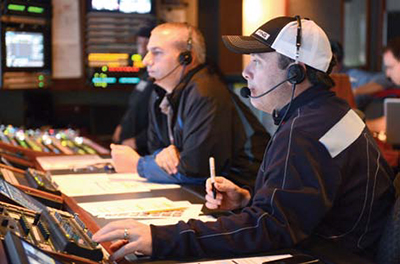High-Octane Communications

ESPN NASCAR Producer Jim Gaiero stays in touch with the production crew via an RTS/Telex Adam matrix intercom system.
OTTAWA—When it comes to covering events such as NASCAR, Fox and ESPN have to coordinate dozens of camera positions across posses of production trucks, and integrate all of this footage with color commentary and audio from the race cars in real-time.
This is where the great unsung heroes of auto racing—modern intercom systems— make all the difference. Today’s matrix-based, software-programmable point-to-point and partyline intercom systems allow ESPN and Fox producers control their far-flung camera teams and in-truck personnel effectively and without confusion. These same systems also connect the drivers on the track with their pit crews and off-site engineers, providing drivers with up-to-date tactical advice and on-track support.
BROADCASTERS’ INTERCOMS
ESPN and Fox rely on the RTS/Telex Adam matrix intercom system for their mobile NASCAR broadcasts. Adam is a full-size modular matrix intercom system, which is housed in one of each network’s mobile production trucks.
“Our Adam intercom has 274 ports, which connects from our trucks to our talent, our camera operators, and back to our network control center,” said Denis Ryan, ESPN’s lead audio mixer. Fox Sports’ Adam intercom is configured for upwards of 480 ports, and has a similar configuration, according to Kevin Callahan, Fox Sports’ director of technology.
Unlike traditional intercoms which relied on patch panels for setting inputs and outputs, the RTS/Telex Adam’s connections are programmed via computer. This allows operators to create a series of presets for each broadcast that can be accessed at the push of a button. Users are connected in the truck using push-button key panels. Mobile crew members wear wired or wireless beltpacks, or, in the case of the camera crew, connect by plugging in their microphone-equipped headsets directly into their cameras’ CCUs.
Intercoms are typically configured in two ways. The first is a series of predefined person-to-person connections, making it simple for the director to talk to each camera position with the push of a LED-labelled button, knob, or switch. (The LEDs display short alphanumeric titles, which can be manually set and reset as needed.) The second configuration is the “partyline,” where more than two people can listen and talk on a shared common channel.
Get the TV Tech Newsletter
The professional video industry's #1 source for news, trends and product and tech information. Sign up below.
Selecting and programming the most useful and needed person-to-person pathways is an important responsibility. Effective switching and camerawork in the heat of NASCAR requires the correct connections to be right at the director’s fingertips.
The cabling and hardware chosen also matters: Fiber-optic links are favored over copper not just because of their superior capacity for IP-based traffic—and modern intercoms are IP-based—but because copper will conduct power surges when hit by lightning.
“Weather is just one of the challenges we face with our intercom systems,” said Callahan. “Noise is another big issue. Even with the best noise-cancelling algorithms and protective earwear, getting and receiving intelligible audio at track-side can be very, very difficult.”
Small wonder: Studies by the Centers for Disease Control and Prevention have measured NASCAR audio levels reaching 96 dBA for spectators and camerapeople in the stands. This is two to 10 times higher than a person working a 40-hour week at the maximum allowable limit of 85 dBA is exposed to, according to the CDC. Drivers can experience audio peaks of up to 140 dBA at full speed!
ADD IN THE CARS AND PIT CREWS
Listening to the live chatter between drivers and crews is a big part of auto race broadcasts; not just for NASCAR, but also at Indy car and Formula One races. This is why these crews also use broadcast-style intercom systems; again adopting the matrix programming model, with the drivers being connected to people on-site and engineers watching the race back at headquarters. This is what modern intercoms have brought to auto racing: When you see a driver suddenly overtake the leader, chances are he is doing so based on a team decision made possible by real-time audio communications.
“We equip each car with a Kenwood radio mounted inside one of our custom carbon cases, which transmits back to receivers around the track,” said Ken Rumbold, director of MRTC, one of Clear-Com’s channel partners in the United Kingdom that services major racetracks such as Silverstone. “We use the Clear-Com Eclipse HX-Median digital matrix intercom to collect these signals and connect them with the pit crews, engineers onsite and off-site, and directly into the broadcasters’ intercoms for relay straight to air.”
At the Monaco Grand Prix, Riedel Communications draws on its suite of Artist digital matrix intercoms to keep drivers and crews connected. “We can have up to 250 people using the system at a time,” said Dario Rossi, head of Riedel’s Motorsport division. “Because our equipment moves around on the Formula 1 circuit, it is all ‘soft-mounted’ to endure bumps during transportation, and cooled to survive the 105 degree heat (Fahrenheit) in Abu Dhabi.”
James Careless is an award-winning journalist who has written for TV Technology since the 1990s. He has covered HDTV from the days of the six competing HDTV formats that led to the 1993 Grand Alliance, and onwards through ATSC 3.0 and OTT. He also writes for Radio World, along with other publications in aerospace, defense, public safety, streaming media, plus the amusement park industry for something different.

